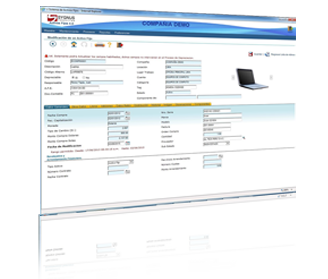SYGNUS Web / Fixed Assets IFRSs
| Overview | Description | Characteristics |

 Compatible with IFRS standards Compatible with IFRS standards |
 Multiple books and categories Multiple books and categories |
 Partial retirements and transfers Partial retirements and transfers |
 Decomposition of Assets Decomposition of Assets |
 Depretiation: Depretiation: |
| • Straight line |
| • Units of Production |
 Depretiation of revalued assets Depretiation of revalued assets |
 Structured Codes Structured Codes |
|
For a better financial decision making in organizations, the administrative and managerial control of assets should be based on the International Financial Reporting Standards (IFRSs). Permanently updated information allows a company to manage comprehensively its fixed assets. The SYGNUS Web/Fixed Assets system helps control all asset values since its acquisition, modifications during its lifetime, until retirement. Provides all the flexibility to administer the financial value oy yous company’s assets. It provides critical information for both finance and logistics areas. Helps accounting and financial management as well as physical and logistics control. |
|
Characteristics General Characteristics: Flexible Fixed Assets Coding: The asset codes is generated automatically based on a prefix and correlative number defined by the company; Asset Classification: An asset can be classified by location and by cost center. Dynamic Fields: In addition to the standard Master Asset File fields, one can define up to 20 additional fields as per user requirements; Images: The system allows to save asset images and scanned documents within its General Description (preferably with .jpg extensions); Multicompany: Manages an unlimited number of companies; Multiuser: Unlimited number of users can access the system, according to authorizations given by the system administrator; Double Currency: The system allows to register values in Nuevos Soles and US dollars; Books: Multiple books can be defined: Financial, Tax, Corporate, etc. Depretiation Methods and Rates: The system include the following depretiation methods: lineal or Units of production depretiation. Also, the system allows the use of different depretiation rates for Financial, Tax, etc. purposes; and an specific Fixed Assey can have a different depretiation rate than the its general accounting classification rate. Monthly and Daily Depretiation:The System allows the monthly and daily depreciation calculation for his various books (different depreciation rates: financial, tax, corporate, other), locations, categories, companies, periods, as many times as necessary before the generation of the respective accounting entries. Accounting: The system allows the automatic generation of the accounting entries for the new and retired assets, in a monthly or daily cycle. Entries may be distributed by cost centers. Improvements to an Asset: The system allows to register improvements: additions, adjustments, alterations, transformation, partial withdrawals or partial transfers, keeping this information as if this improvement were a separate fixed asset assets. In this way we will be able to analyze all detailed information throughout the useful life of the asset and allowing posting improvements separate from the original fixed assets value. Reassessments, transfers, and retirements of fixed assets: The system allows to register devaluations or revaluation of a fixed asset affecting directly its cost. For transfers of an asset, the change of location, place of work, ledger account and category, which registers the date and the reason for removal of the fixed asset, is recorded for the transfer. Partial Transfers and Retirements of a Fixed Asset: For fixed assets that contain more than one unit (for example: a railroad track where part of the track can be relocated), the system can process partial transfers to another location or to unsubscribe to a certain number of units that conform the asset. All data required to determine and record this transfer or retirement, has to be entered manually, i.e., they are not generated automatically. Decomposition of Assets: The system allows to register components associated to a fixed asset, so that you can keep track of its components individually. Allows each of the fixed assets, after its individual creation, to be able to relate with any other fixed asset, necessarily under a parent-child hierarchy. This functionality is only a way of grouping among the different fixed assets of the company. Security: The system allows the user to modify all data, depending on the level of security given by the administrator. Each of the modifications is registered in the system in order to provide a “change log” for management control. Processes: The system allows for various processes: calculation of depreciation, locking, RollBack and generation of accounting vouchers. Reports: The system allows to issue various fixed assets control reports such as: accounting reports, new and retired assets, fixed asset master file, asset decomposition, asset inventory, SUNAT tax reports, etc. In addition, it allows the export of reports to a Microsoft Excel, TXT or PDF files. |


